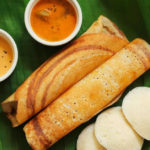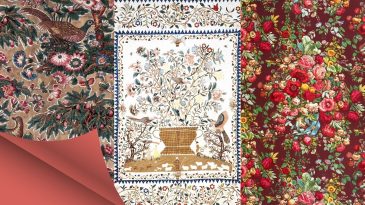- Made in India
- Updated on July 9, 2025
Chintz Fabric: History, Uses, Care & More

Do you love bold colors and beautiful floral designs? If so, then chintz fabric might be your new favorite! Chintz is a classic fabric with a rich history, known for its vibrant prints and smooth, polished finish. From its origins in India to its popularity in homes today, chintz offers a touch of elegance and personality to any space. Let’s explore the world of chintz, from its exotic origins to its versatile uses in modern. But first learn, how to identify the chintz fabric
Chintz might feel a bit on the stiff side at first, like a new pair of jeans. This is because of the tight weave used for durability. But don’t worry, it softens up with use! To identify chintz, look for two key things:
- Bold floral prints in vibrant colors steal the show and
- a smooth, shiny surface that feels almost polished. If a fabric boasts these features, you’ve likely found some beautiful chintz!
How is Chintz Fabric Made?

Making chintz is like a secret handshake! First, cotton gets woven into a strong base. Then, artisans use carved blocks dipped in dye (or paint!) to create those amazing flower patterns. Finally, the fabric gets squished by hot rollers to make it shiny and smooth – that’s the chintz magic! Today, machines might help with printing, and sometimes other materials get mixed in, but the basic steps are still the same.
What is Chintz Fabric?
It’s a type of cloth made from cotton, usually with a smooth, shiny surface. The most famous thing about chintz is its patterns – big, bold flowers in all sorts of colors.
Think of those pretty floral curtains you might see in your grandma’s house. Those could very well be chintz! It’s a classic fabric that’s been around for hundreds of years, used for things like curtains, chair cushions, and even some clothes.
History Of Chintz Fabric

Chintz, with its vibrant florals, originated in India in the 16th century specifically in the Golconda region (present-day Hyderabad). Skilled artisans used cotton and woodblock printing to create stunning “chint” (meaning “spotted” in Hindi) designs.
European traders like the Dutch and Portuguese fell in love with chintz. They brought it back to Europe, where it became a prized possession for royalty and the wealthy. Homes were adorned with chintz furniture, curtains, and bed covers, adding a burst of color and luxury.
Chintz’s popularity soared, becoming a symbol of sophistication. Its bold florals graced not only home decor but also clothing. The influence spread beyond Europe, with countries like Japan adopting chintz.
While less common in clothing, chintz remains a beloved choice for interior design. Upholstery, curtains, and accents benefit from its vibrancy and elegance.
Chintz’s journey is a testament to the enduring power of beautiful design, captivating the world with its colorful blooms for centuries.
Types of Chintz Fabric

While there isn’t a vast variety of “types” of chintz fabric, there are some key distinctions based on the material composition:
Traditional Chintz: This is the classic chintz, made entirely from cotton. It features a plain weave, giving it a sturdy base, and the signature glazed or polished finish. This traditional version offers a natural, breathable feel.
Chintz Blends: Modern chintz fabrics often incorporate synthetic fibers like polyester or viscose alongside cotton. These blends can offer some advantages:
- Wrinkle Resistance: Synthetic fibers can help chintz resist wrinkles more effectively than pure cotton.
- Durability: Blends may offer slightly better durability, especially in high-traffic areas.
- Cost: Sometimes, blended chintz can be a more affordable option compared to pure cotton.
Choosing Between Cotton and Blends:
Here’s a quick guide to help you decide:
- Go for pure cotton chintz if you prioritize breathability, a natural feel, and a more traditional look.
- Opt for a chintz blend if wrinkle resistance, durability, or affordability are your main concerns.
Uses and Application of Chintz Fabric

Chintz fabric is all about bringing a burst of color and pattern to your life! But how can you use it? Let’s break it :
- Sofas & Chairs: Want to make your couch or chair more fun? Chintz can be used to cover furniture, making it look fancy and holding up well to everyday use.
- Curtains: Boring windows? Not anymore! Chintz curtains with bright colors and patterns liven up any room, letting in light and adding some cheer.
- Extra Touches: Chintz isn’t just for big things! You can use it for cute throw pillows, colorful tablecloths, or even stylish lampshades. It’s a great way to add pops of color and a touch of fancy to your home.
- Clothes: Chintz fabric used to be popular for clothes, like dresses and jackets. But it’s a bit stiff and other softer fabrics became more popular. Now you might only see chintz in special outfits or clothes that look like they’re from the past.pen_spark
Is Kalamkari and Chintz same?
India boasts a rich textile heritage, and two vibrant fabrics, kalamkari and chintz, showcase its artistic legacy. Both made primarily from cotton, they bring a burst of color to any space. But while they share some similarities, their creation and aesthetics differ.
Kalamkari is like a hand-painted storybook, often featuring mythological scenes or detailed artwork using resist-dyeing techniques (where wax blocks color). Each piece is practically one-of-a-kind.
Chintz, on the other hand, is a celebration of bold floral or geometric patterns. Woodblock printing creates vibrant designs, followed by a special calendering process that gives chintz its characteristic shiny finish. This allows for more mass production compared to Kalamkari.
What sets it apart from other fabric in India?
Chintz fabric possesses a set of distinctive characteristics that make it stand out from other fabrics. Firstly, its texture is medium-heavy, resulting in a smooth and glossy feel that immediately catches the eye. When utilized for clothing or home decor, chintz fabric drapes elegantly, forming structured folds that bring a touch of sophistication to any environment.
Another notable feature is its subtle sheen, adding a luxurious touch to both garments and furnishings. Moreover, chintz fabric is highly durable, known for its remarkable strength that ensures it can withstand everyday wear and tear without the fear of ripping or tearing. Additionally, the fabric exhibits excellent absorbency, efficiently soaking up moisture and keeping you comfortable even in humid conditions.
When considering chintz fabric, it is the perfect combination of texture, draping ability, sheen, durability, and absorbency that distinguishes it as a unique choice for fashion and home décor applications. Embrace the elegance and practicality of chintz fabric in your own experience.
Is Chintz Fabric Costly?
Chintz can vary in price depending on several factors:
- Material: Pure cotton chintz is generally more expensive than blends with polyester or viscose. Blends might be more affordable but may lack the breathability of pure cotton.
- Quality: The quality of the cotton and the intricacy of the printing process can also affect the price. Higher-quality materials and detailed prints will typically cost more.
- Source: Where you buy the chintz can also influence the price. Fabric stores might have a wider range of options compared to discount stores, potentially affecting the cost.
Care and Maintenance of Chintz Fabric
Keeping your chintz fabric happy is like taking care of a pretty flower!
First, check the tag – some chintz can be washed with gentle soap and cool water in the washing machine, just like your favorite shirt! But others might be more delicate and need a special visit to the dry cleaners, like your fancy dress.
Spills happen, so act fast! Grab a clean cloth and blot up the mess (don’t rub, or it might spread!). You can use a little bit of dish soap mixed with water to gently dab the stain, then wipe it clean with plain water.
Ironing is okay for some chintz, but always check the tag first and iron on the back if possible. If your chintz wrinkles easily, a steamer might be a gentler option.
Remember, too much sunshine can fade the bright colors, so keep your chintz out of direct sunlight.
Finally, give your chintz a little TLC by dusting it with a soft brush or vacuum cleaner attachment sometimes to keep it looking fresh and beautiful for a long time!
Read Also : Exploring the Secrets Behind the Success of Leading Made in India Brands
Conclusion
From its origins in India to its modern uses, chintz fabric has captured hearts with its unique charm. This cotton wonder adds a burst of color and personality to any space. Whether you’re looking for eye-catching upholstery or bright curtains, chintz offers a timeless elegance that can elevate your home decor. So, next time you’re decorating, consider the delightful world of chintz – it might just become your new favorite fabric!
Join the discussion
Related Articles
No results available
ResetTrending Articles


- General
- Updated on December 11, 2025


- General
- Updated on December 11, 2025


- General
- Updated on December 11, 2025


- General
- Updated on December 2, 2025


- General
- Updated on December 5, 2025


- General
- Updated on November 27, 2025


- Health
- Updated on November 24, 2025


- General
- Updated on November 24, 2025


- General
- Updated on November 19, 2025


- General
- Updated on November 19, 2025
No results available
Reset


